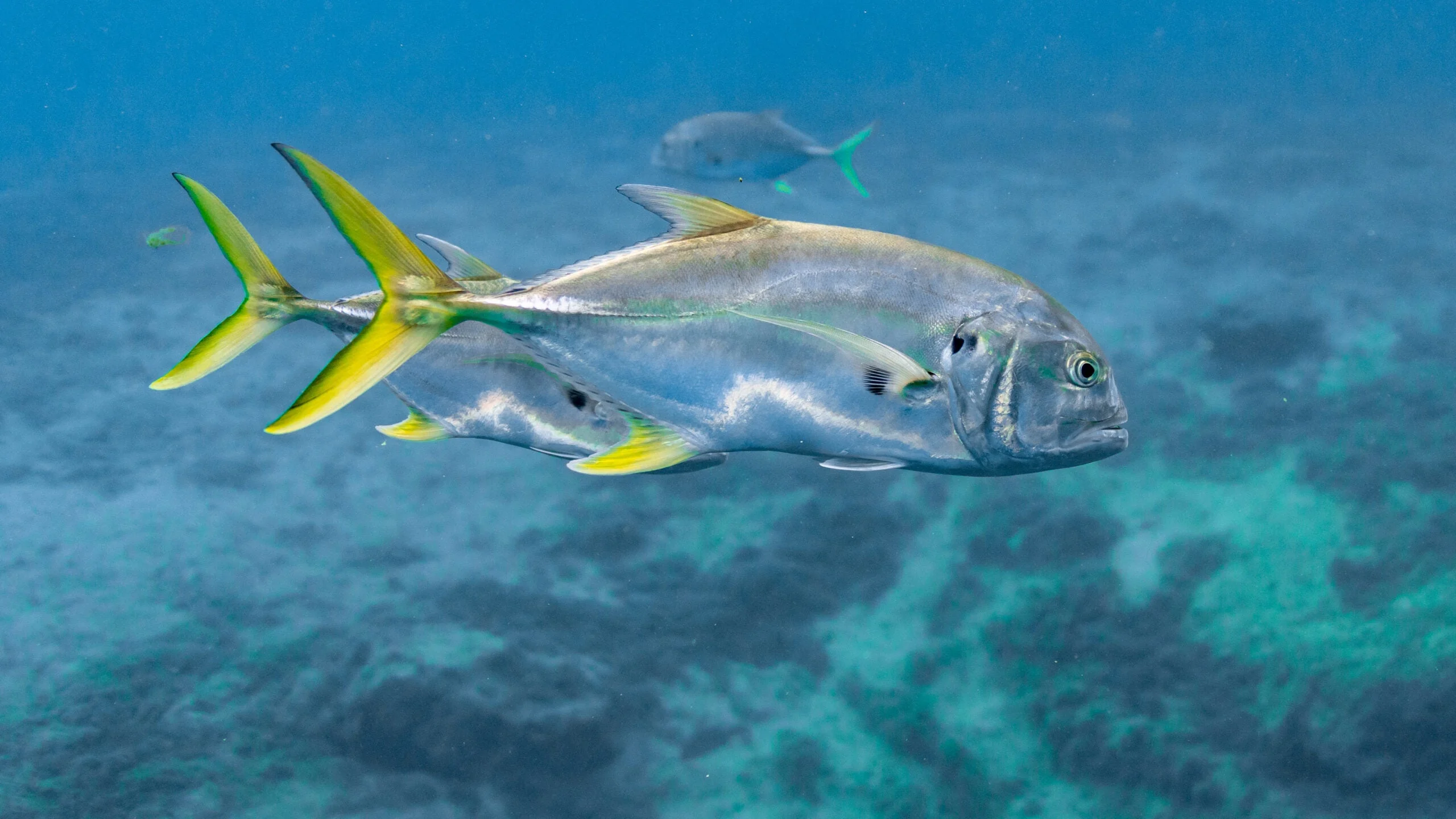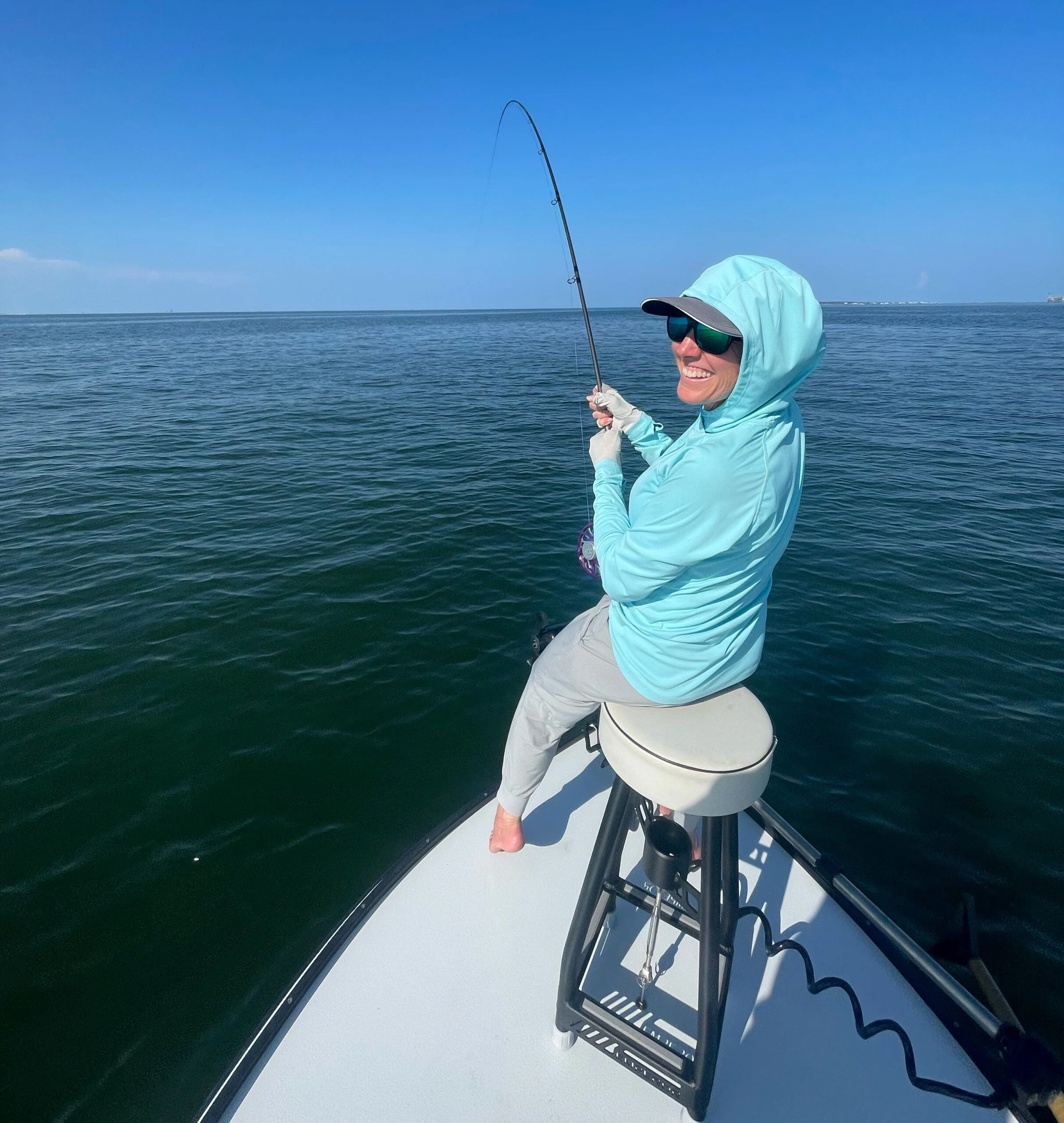He’s yelling strip, but we’re not at a bar or in a club. We’re on a flats boat in Mobile Bay, Alabama, and I’ve hooked my first crevalle jack. They’re also known as the poor man’s GT because fishing for crevalle in the states is cheaper than fishing for giant trevally in Australia.
I come from the West’s cold-water trout country. I know how to strip line for big browns and bows, but the beast on the other end of my line feels nothing like those. It doesn’t feel like Chinook salmon or Belize bonefish, either. It’s madder than both combined.
There’s a tremble in my forearms, humidity sliding down my back, and a bruise on my hip from the butt of my fly rod
and what I’ve hooked is about to yank me into the water. Sam Glass, the guide yelling strip, witnesses my unintentional LDR (long-distance release) 10 minutes after I set the hook. He has a long day ahead with me in his boat and I have a lot to learn, so I put myself to task for all our sakes.
Here’s how to spot, hook, land, and eat a fighting fish few consider table fare.
Spotting Jack Crevalle

Crevalle are found in the Gulf of Mexico and along the eastern seaboard as far north as Virginia. Adobe Stock / Phil Lowe
Before you can properly spot crevalle, you should be able to properly pronounce what you’re looking for. You have two choices: crevalle jack or jack crevalle. Jack sounds the same either way, but crevalle varies. Mobile Bay locals say cre-val, as in Valerie. Visitors say cre-volley, as in volleyball.
There are other jacks in the carangidae family with crevalle, including permit, greater and lesser ambers, and Florida pompano. They’re all strong, boney, fighting fish. Permit are more aggressive than pompano. Ambers hang out in deep water around structure, like drilling rigs, while crevalle cruise sandbars looking for bait fish called pogies.
Crevalle are found in the Gulf of Mexico and along the eastern seaboard as far north as Virginia. They’re widely distributed from coastal rivers to 20 miles off shore, but they’re easy to spot when they’re up. When you see sparkling spikes poking out of the water near Gulf Shores, Alabama, from June through November, it’s probably a school of crevalle jacks.
“One of my favorite ways to target jacks is to pull up behind a shrimp boat in the summer in Mobile Bay as they discard their bi-catch,” says Craig Newton, Alabama Department of Conservation and Natural Resources
supervisory fisheries biologist. “Jacks come up behind the shrimp boat, you cast, they bite quick and you just hold on.”
Hooking Jack Crevalle

to the hardest strikes you’ve experienced in your fishing career, as these fish are both aggressive and competitive. A solo cruiser won’t be easily enticed, but throw a dozen into a riot and it’s mayhem with every mouth trying to munch whatever you throw. Flyway Charters
Crevalle bite quick, but not just out of hunger. Add a layer of rage to the hardest strikes you’ve experienced in your fishing career; these fish are both aggressive and competitive. A solo cruiser won’t be easily enticed, but throw a dozen into a riot and it’s mayhem with every mouth trying to munch whatever you throw.
“You can get them to eat anything when there’s that school drive,” says Captain Sam Glass, Flyway Charters
owner and guide. “Anything you can get in front of them including a barbie doll, if you can work it right, they’re pretty happy.”
I flew to Alabama with some streamers and an 8-weight fly rod. Neither came out of their cases. Glass had me casting a GT popper with an 11-weight fly rod. The other angler in the boat, Easton Colvin, used an 8-foot spinning rod baited with a tuna popper, with which he landed his first jack. Glass landed every jack he targeted with either rod, releasing them nearly as fast as he found them.
Glass uses a combination of poling and trolling to maneuver his flats boat, and whoever is casting, into position. Whether it’s fly or spin, both casts require long lead. Crevalle compete with each other to get to the bait, but they don’t want to come to the boat so throw at least 10 feet of line.
“The dream is they’re out there smacking bait and throwing whitewater everywhere,” Glass says. “It’s easy pickings at that point as long as they stay up.”
Landing Jack Crevalle
You need more finesse to land a jack than to catch a jack crevalle. I don’t have finesse. I held on to my one hook-up long enough for all three of us to estimate its 25-pound heft. But when it was within arm’s reach of the boat, I accidentally let up on the line and the fly went slack in the fish’s mouth. My long-distance release doesn’t count as a land even if there a was solid connection between fisher and fish for a few minutes.
Glass knows how to get them in the boat when they’re 25 pounds and when they’re bigger. The Alabama state record
is a 40-pound crevalle caught in 2014. Glass catches 30-pounders regularly and he has them to the boat quick. He cranks on the reel angling rod tip left and right to keep the hook stuck jaw-tight. His feet are planted behind a stool bolted to the floor and his hands are covered.
“Gloves for jacks on the fly for sure,” Glass says. “A little bit of glove helps when that reel starts zinging. They’re a protective measure when things are moving fast and things are sharp.”
He also keeps heavy-duty pliers in his boat for hook removal. He grabs the leader and the tail to wrestle the fish into a mellow state in the boat’s base then uses pliers to pull the hook from the jaw without touching gills. There’s a grip-and-grin photo if the angler is a first-timer, and then the crevalle is released. Glass doesn’t keep jacks.
“You can eat anything you can fit in your mouth, but jack is not high on my list to eat,” he says. “Drug dealers shouldn’t get high on their own supply.”
Time to Eat
Hank Shaw keeps jack crevalle. He calls them the cheetahs of the water because they’re so fast. Shaw is a hunter, an angler, an author, and a chef. If his Gulf catch fits on a grill, he eats it, but crevalle need special care before consumption. Parasites are a possibility, and crevalle have a reputation for being trash fish. While the negative label is a terrible myth, the worms are a legitimate concern.
“There’s a parasite issue with jacks,” says Shaw, author of Hook, Line and Supper. “They are big and you can see them. Not all jacks have worms but jacks in the Gulf of Mexico, especially big ones, can be wormy. When in doubt fillet instead of preparing whole.”
As soon as the hook is out, bleed the fish by running a stringer through the gills and hanging it over the side of the boat to dangle in saltwater. Gut the fish on board, too. Energetic fish get belly burn. Enzymes are still active after fast fish die. That can diminish flavor and firmness so get the organs out to stop the burn. Also keep a saltwater-ice slurry on board so your cleaned catch can soak in the mixture until you dock for dinner.
“All jacks like to be grilled and smoked,” Shaw says. “Jacks don’t like to be fried. You can fry them, but they are not at their best.”
Shaw toggles between searing and sautéing with sauces ranging from salsa to horseradish. He leans toward spice, as he believes a strong-flavored fish deserves strong ingredients. He makes a jack-heavy soup called Caribbean Fish stew
, but sandwiches work well, too.
“Jacks make a pretty darn good grilled fish sandwich,” he says. “Not a fried one. A grilled one.”
They also freeze well and can be thawed about a week later to eat raw. As for taste, Shaw’s chef-seasoned palate describes the taste of crevalle by comparison.
“Less fishy than mackerel, and more fishy than snapper,” he says. “Fattier than grouper, but not as fatty as salmon or tuna.”
I have yet to eat—or even land—the poor man’s GT but I can spot them and I can hook them. That’s a decent start for a beginner.
Outdoor journalist Kris Millgate is based in Idaho where she runs trail, chases trout and hunts birds. She followed salmon migration solo during the pandemic for the Emmy-nominated film Ocean to Idaho_. Her new film,_ On Grizzly Ground_, is available now along with her third book_ My Place Among Beasts_. See her work at_ www.tightlinemedia.com
.






